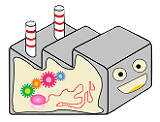Team:Gifu/Safety
From 2014.igem.org




Welcome!
Visit the Safety Hub to see this year's safety requirements. The Safety Hub is the central page for everything related to safety in iGEM. You can also go there to learn about general biosafety topics, and how to think about the future implications of your project.
Edit this page!
Please use this page to write about anything related to safety in your project.
Your Lab
Use this section to tell us about your laboratory. Where is it located? What sort of equipment do you use every day? Have you decorated it for the summer? How do you look wearing a lab coat? Take pictures! Show off your space!
Timeline
- Now : Read the Safety Hub and learn about safety in iGEM. Ask questions by emailing safety at igem DOT org .
- Now - Jamboree: Complete Check-Ins and receive approval before acquiring and using certain materials in your lab
- Now - Wiki Freeze: Edit this Safety page to tell us about what you're doing
- June 9: Submit the About Our Lab form.
- Let us know by June 25 if you will need an extension on the Preliminary Version, or your Preliminary Version will be significantly incomplete.
- June 30: Submit the Preliminary Version of the Safety Form.
- Participate in Virtual Open Office Hours to ask questions and discuss safety topics (exact date to be determined).
- September 1: Submit the Final Version of the Safety Form.
- October: Wiki freeze (exact date to be determined)
- October 30 - November 3: GIANT JAMBOREE!
Safety
Basic Safety Questions for iGEM 2014
- Your Training
- Have your team members received any safety training yet?
- Please briefly describe the topics that you learned about (or will learn about) in your safety training.
- Please give a link to the laboratory safety training requirements of your institution (college, university, community lab, etc). Or, if you cannot give a link, briefly describe the requirements.
- Your Local Rules and Regulations
- Who is responsible for biological safety at your institution? (You might have an Institutional Biosafety Committee, an Office of Environmental Health and Safety, a single Biosafety Officer, or some other arrangement.) Have you discussed your project with them? Describe any concerns they raised, and any changes you made in your project based on your discussion.
- What are the biosafety guidelines of your institution? Please give a link to these guidelines, or briefly describe them if you cannot give a link.
- In your country, what are the regulations that govern biosafety in research laboratories? Please give a link to these regulations, or briefly describe them if you cannot give a link.
- The Organisms and Parts that You Use
Yes, we have already received safety training.
We learned about recombinant DNA technology guideline and things to be careful of when working in laboratory. And one of team members, Kenta Nomura, had a training to learn handling of hazardous materials, and he teaches us tips for experiment.
For detail information about safety training please refer to the site below (Japanese): http://web.jim.gifu-u.ac.jp/sienka/DNA/
The supervisor at our institution is Professor Hiroyuki Koyama, responsible for biological safety at Gifu University. A team instructor, Akio Ebihara, had already explained to him what we were going to do in our iGEM project. He mentioned that there is no special concern in our project because our experiment is similar to a practice course for undergraduate student. And Prof. Koyama permitted us to do the project.
Our University is under ISO14001. We follow its rules. Law concerning the conservation and sustainable use of biological diversity through regulations on the use of living modified organisms (Cartagena Agreement): http://www.gifu-u.ac.jp/images/12/rule/05dna.pdf
http://www.lifescience.mext.go.jp/bioethics/anzen.html http://www.bch.biodic.go.jp/english/cartagena/images/e_cartagena.pdf
 "
"